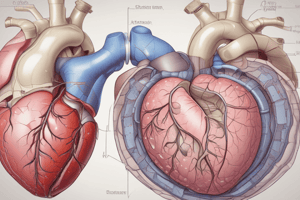Podcast
Questions and Answers
What is the most common cause of mitral stenosis?
What is the most common cause of mitral stenosis?
- Calcification due to aging
- Rheumatic fever (correct)
- Congenital heart defects
- Radiation therapy
Which of the following is NOT a common symptom of mitral stenosis?
Which of the following is NOT a common symptom of mitral stenosis?
- Swelling of the legs
- Palpitations
- Severe headaches (correct)
- Chest discomfort
What classification indicates severe mitral stenosis based on valve area?
What classification indicates severe mitral stenosis based on valve area?
- < 1.0 cm² (correct)
- 1.0 - 1.5 cm²
- 1.5 - 2.0 cm²
- > 1.5 cm²
Which diagnostic method is primarily used to visualize the degree of mitral stenosis?
Which diagnostic method is primarily used to visualize the degree of mitral stenosis?
What is one potential complication directly associated with atrial fibrillation due to mitral stenosis?
What is one potential complication directly associated with atrial fibrillation due to mitral stenosis?
Study Notes
Definition
- Mitral stenosis is a narrowing of the mitral valve opening, restricting blood flow from the left atrium to the left ventricle.
Causes
- Rheumatic fever (most common cause, often following streptococcal throat infection).
- Congenital heart defects.
- Calcium buildup due to aging (also known as mitral annular calcification).
- Radiation therapy to the chest.
Symptoms
- Fatigue and weakness.
- Shortness of breath, especially during exertion or when lying flat.
- Palpitations (irregular heartbeats).
- Swelling of the legs or abdomen.
- Chest discomfort or pain.
- Cough, sometimes producing blood (hemoptysis).
Pathophysiology
- Increased pressure in the left atrium due to restricted outflow.
- Risk of atrial fibrillation due to atrial enlargement.
- Pulmonary hypertension can develop due to elevated pressure in pulmonary circulation.
Diagnosis
- Physical exam: Presence of a typical diastolic murmur.
- Echocardiography: To assess the degree of stenosis and valve morphology.
- Chest X-ray: May show left atrial enlargement and pulmonary congestion.
- Electrocardiogram (ECG): Can reveal atrial fibrillation or signs of left atrial enlargement.
Classification (Severity)
- Mild: Valve area > 1.5 cm²
- Moderate: Valve area 1.0 - 1.5 cm²
- Severe: Valve area < 1.0 cm²
Treatment
- Medical management: Diuretics for fluid overload, beta-blockers or calcium channel blockers for rate control in atrial fibrillation.
- Interventional options:
- Percutaneous balloon mitral valvotomy (ideal for suitable candidates).
- Surgical mitral valve repair or replacement for severe cases or when other interventions are unsuitable.
Complications
- Atrial fibrillation leading to thromboembolic events (e.g., stroke).
- Heart failure due to low cardiac output.
- Pulmonary edema.
Prognosis
- Varies with severity, treatment options, and overall patient health.
- Early intervention can improve outcomes and quality of life.
Mitral Stenosis
- Narrowing of the mitral valve, hindering blood flow from the left atrium to the left ventricle.
- Most common cause is rheumatic fever, often following streptococcal throat infection.
- Can also be caused by congenital heart defects, calcium buildup (mitral annular calcification), or radiation therapy to the chest.
- Symptoms include fatigue, shortness of breath, palpitations, leg/abdominal swelling, chest discomfort, and coughing (possibly with blood).
- Pathophysiology includes increased pressure in the left atrium, risk of atrial fibrillation due to atrial enlargement, and possibility of pulmonary hypertension.
- Diagnosis relies on a physical exam (diastolic murmur), echocardiography (valve assessment), chest X-ray (left atrial enlargement), and ECG (atrial fibrillation or left atrial enlargement).
- Classification based on valve area:
- Mild: > 1.5 cm²
- Moderate: 1.0 - 1.5 cm²
- Severe: < 1.0 cm²
- Treatment options include medical management (diuretics, beta-blockers/calcium channel blockers), percutaneous balloon mitral valvotomy (for suitable candidates), and surgical repair/replacement (for severe cases).
- Complications include atrial fibrillation leading to stroke, heart failure due to decreased cardiac output, and pulmonary edema.
- Prognosis varies with severity, treatment, and patient health. Early intervention can improve outcomes and quality of life.
Studying That Suits You
Use AI to generate personalized quizzes and flashcards to suit your learning preferences.
Description
Explore the critical aspects of mitral stenosis, including its causes, symptoms, and pathophysiology. This quiz will help you understand the implications of this condition on heart function and diagnosis methods. Perfect for students of cardiology or anyone interested in heart diseases.




